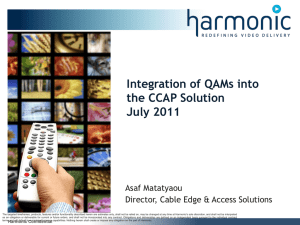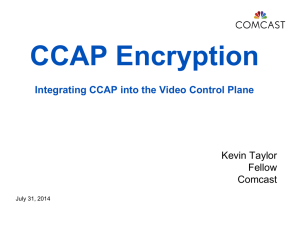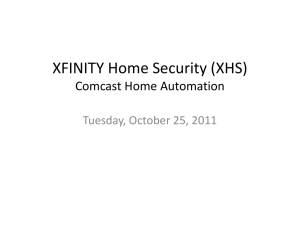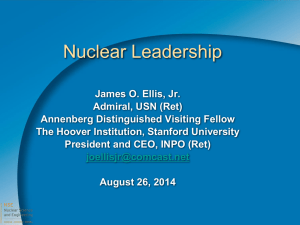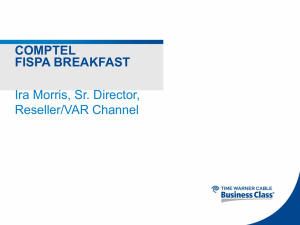Comcast CCAP
advertisement
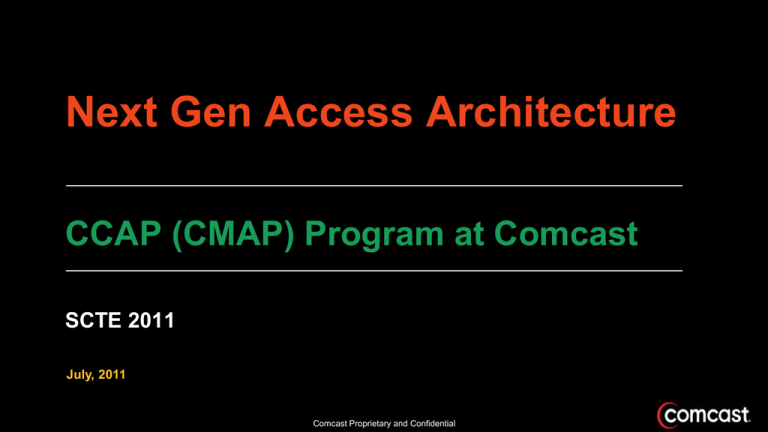
Next Gen Access Architecture CCAP (CMAP) Program at Comcast SCTE 2011 July, 2011 Comcast Proprietary and Confidential Why would MSOs need CCAP? • Engineering: Capacity and efficiency, frees significant HE capacity • • 50% space savings with 4x capacity 60% power savings plus less cooling Improve existing UPS and battery backup performance Architecture: Simplicity and flexibility is already a key driver Minimum, simplified combining wiring Full-spectrum, MPEG/DOCSIS QAMs, easier migration to ADS Future proof, single access platform Purchasing: Cost will quickly become a big driver CMTS 4-6 DOCSIS channel cost equals CCAP 16 DOCSIS + 16 MPEG Channels !! • Operations: Reliability and manageability will also drive adoption 2 Fully redundant (N+1 LC & 1+1 Commons) Configuration change between QAM types vs. equipment swap-out Much shorter maintenance window (ISSU) Far less equipment to manage and maintain Comcast Proprietary and Confidential CCAP space efficiency example Today’s HE: 16 NC QAMs per SG Top view of headend rack line-up Each box represents a rackper SG After CCAP: 64 NC QAMs Digital Broadcast 20 QAMs 20 QAMs 20 QAMs OOB SDV 6 EQAM 6 EQAM 6 EQAM 6 EQAM VOD 6 EQAM 6 EQAM 6 EQAM 6 EQAM CMTS Combiner & Amps CMTS CMTS CMTS CMTS CMTS CMTS CMTS CMTS CMTS CCAP CCAP CCAP CCAP CCAP Ret Fwd Ret Fwd Ret Ret Fwd Ret Fwd Ret Fwd Ret Fwd Ret Ret Fwd Ret Lasers & Receivers OOB Example for illustrative purposes OOB OOB Fwd CCAP eliminates the need for headend expansions NOTES: • Deployment example assuming 40K homes passed, 200 nodes, 140 D3 HSD service groups at 16 SG/chassis, 120 VOD SGs @ 6QAMs/SG and 4 QAMs/RF Port, and same SDV service groups. • Larger or smaller headends would scale accordingly, but savings will be proportional. 3 Comcast Proprietary and Confidential Ret CCAP yearly power savings in a typical headend Pre-CCAP KWH/Year Device Digital Broadcast Post-CCAP KWH/Year KWH Savings Percentage Saved 60,196 0 60,196 100% SDV 140,160 0 140,160 100% VOD 140,160 0 140,160 100% CMTS->CCAP 277,984 227,760 50,224 18% Combine/Amp 5,676 3,784 1,892 33% Lasers/Receivers NA Total 624,176 NA 231,544 NA 392,632 NA 63% CCAP saves 60% of power, not including cooling energy savings! UPS and battery requirements are also reduced – existing capacity will last considerably longer when power is interrupted. 4 Comcast Proprietary and Confidential 16U Chassis Exhaust Air Primary 100-Gig-E Ports Secondary 100-Gig-E Ports 12 Ports/DS Card 32/48/64 Narrowcast QAMs/Port 96 Broadcast QAMs/Port Primary Switch/Route Engine Secondary Switch/Route Engine US Redundancy US US US US US 24 Ports/US Card DS Redundancy DS DS DS DS DS 32/48/64 NC QAMs + 96 BC QAMs SDV MPEG TS DS RF Port VOD nDVR Broadc ast Simplify, and eventually eliminate RF Combining HSD CDV AVS DOCSIS CCAP DS Port Assignments XR2 XR1 CCAP in a nutshell • Converged Cable Access Platform • Combines the functions of the CMTS and Edge QAM • Implements all narrowcast andRear broadcast QAMs View (Implemented using high density UCH w/ MCX-75 connectors) Power Supply Modules Front View 16U Chassis Narrowcast & Broadcast Digital Services Integrated CCAP CCAP DS US Legacy OOB Analog Modular CCAP Fan Modules Intake Air Split Legacy OOB Comcast Proprietary and Confidential Operational features of CCAP Open decryption/encryption interfaces 6 Comcast Proprietary and Confidential Similar boxes for both Integrated vs. Modular CCAP components ICCAP I-CCAP HE Router Sub & Flow Management HE Router / M-CCAP PS Single CCAP Vendor IP PASI Routing M-CCAP ICCAP AS Best-in-Class Expertise Each approach has pros and cons 7 Comcast Proprietary and Confidential CCAP use cases examples (two of several) M-CMTS Core UR UR I-CMTS SDV Shorter Term HE Router UR UEQAM M-CMTS Core US US DS DS UR I-CCAP DS UR M-CCAP AS in DS mode US Longer Term Options Future HE Router US 8 VOD HE Router BCast For M-CMTS markets SDV Bcast Today HE Router VOD Where I-CMTS exists Add density with CCAP Access Shelf in DS-only mode DS Eventually I-CCAP or… • Migrate to I-CCAP & relocate CCAP-AS • Or, add CCAP PS Comcast Proprietary and Confidential …M-CCAP HE Router UR UR I-CCAP US • Existing Router w/PS SW HE Router / M-CCAP PS UR M-CCAP AS DS US DS • Add US LCs CCAP migration options Capacity Augment New Service Deployment • Drop in CCAP as SGs are split or EQAMs/CMTSs are added • Keep current equipment and eventually move to other locations • Add CCAP for new service • Maintain existing equipment for existing services • Eventually integrate other services into CCAP Broadcast and OOB Broadcast and OOB CCAP for New Service CCAP Combiner 9 Broadcast and OOB New SGs CCAP CMTSs Combiner Lasers and Receivers Existing SGs • Add CCAPs for all SGs in key HEs • Independent of services • Existing equipment relocated SDV/VOD EQAMs SDV/VOD EQAMs CMTSs Infrastructure Upgrade Combiner Lasers and Receivers Lasers and Receivers Existing SGs Comcast Proprietary and Confidential Existing SGs Preparing for CCAP • Work underway in the many areas at Comcast: Systems: configuration, monitoring, logging, fault detection, trouble management, inventory, databases, etc. Operations: changes to deploy and manage single device Testing: process (who/how/when and what order), and edge QAM, DRFI performance, new features, and new services (RS-DVR, AVS) • Deployment planning: Network models for system types: very large to very small HEs Trials starting in 2011: operational readiness focus, not equipment • New combiner equipment: optimized for CCAP and remaining inputs • Working with Motorola and Cisco on encryption licensing model and ECMG implementation plan 10 Comcast Proprietary and Confidential CCAP operational readiness trial – concept diagram • CCAP-like network to understand technical/ops issues and prepare Operational processes, tools, network engineering, etc. • The trial is about MSO operations, NOT to test equipment • The scope will be minimal but meaningful (few service groups) DTA BCAST SDV VOD 2-4 6 M-CCAP AS in DS-only mode 4 4 M-CMTS Core 11 OTHER QAMs ANALOG TEST 20-24 Combiner Collaborative effort with Cox and Rogers All services 4 Comcast Proprietary and Confidential ~120 DS US Completing CCAP specifications • Large team of industry experts developing CCAP specs Key engineers and architects from all EQAM and CMTS vendors Agreements with Cablevision, Charter, Cox, LGI/UPC, NCTC, Rogers, and others, plus working with TWC on common requirements Direct support from CableLabs; now working on CL CCAP Specs Cable Europe Labs representing the 15 largest MSOs in Europe • MSO specification documents: Phase 1 completed in March 2010 (focus on HW & Functions) Phase 2 completed in July 2010 (added Config & Mgmt and PASI) Phase 3 completed in Nov. 2010 (expanded all specs; wrote CL TR) Phase 4 in progress, adding adv. Functions, ATP and updated CL TR (target Sept. ’11) – CableLabs working on CCAP OSSI and PASI specs – Changed name to converge TWC and Comcast efforts Comcast Proprietary and Confidential 12 Thank Summary and conclusions • CCAP Platform is the Next Gen CMTS and Edge QAM You!! Natural technology evolution; cost effective, simple and redundant Supports all digital services (VOD, SDV, Broadcast, HSD/voice) Easy migration from MPEG-TS to DOCSIS • Many MSOs need the CCAP ASAP Operational simplicity and benefits are staggering CCAP QAMs are much more cost effective • Expect initial trials in 2011 and initial deployments in 2012 • Please let us know of any interest in participating, or of questions, comments and especially suggestions jorge_salinger@cable.comcast.com saifur_rahman@cable.comcast.com Comcast Proprietary and Confidential 13


